Organisational Learning and Change: Essay on Strategies and Barriers
VerifiedAdded on 2022/09/18
|6
|1921
|22
Essay
AI Summary
This essay delves into the concept of organizational learning, highlighting its importance in creating, retaining, and transferring knowledge within an organization. It examines how adopting new technologies and social media techniques can facilitate learning and adaptation for long-term success. The essay explores the role of managers in fostering knowledge creation, retention, and transfer, emphasizing the need for continuous learning about customers, business, and the environment. It identifies various factors that influence the success or failure of organizational learning, including efficiency, training, manager engagement, and resistance to change. Furthermore, the essay discusses barriers to organizational learning, such as short-term focus, lack of motivation, insufficient leadership training, and staff resistance to change. It then presents strategies for improving organizational learning, including innovative knowledge sharing, rewarding and identifying individuals for knowledge, focusing on in-the-moment learning, and adjusting employee mindsets. The essay concludes by emphasizing the importance of leadership alignment and sponsorship in creating and maintaining a robust organizational learning culture.
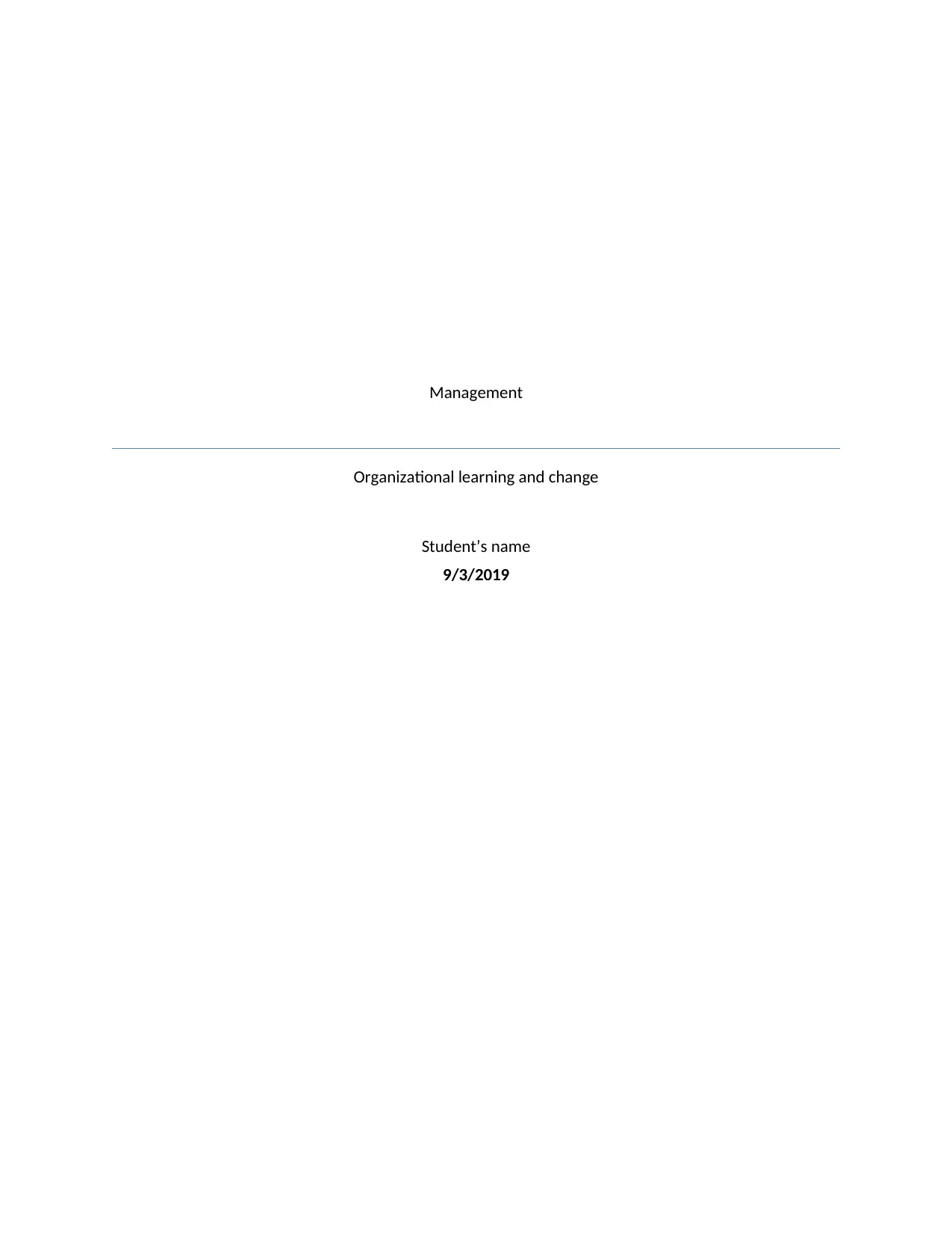
Management
Organizational learning and change
Student’s name
9/3/2019
Organizational learning and change
Student’s name
9/3/2019
Paraphrase This Document
Need a fresh take? Get an instant paraphrase of this document with our AI Paraphraser
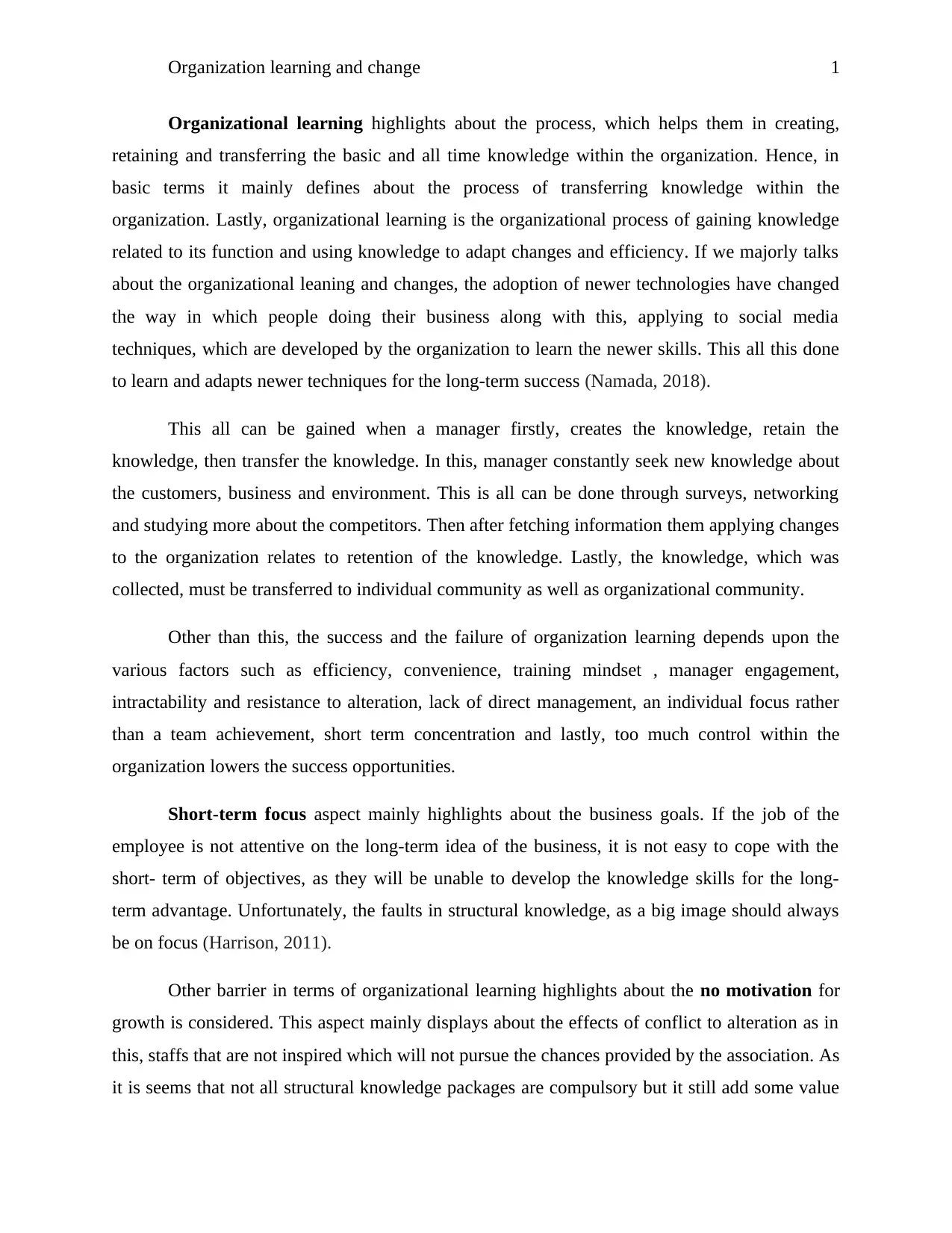
Organization learning and change 1
Organizational learning highlights about the process, which helps them in creating,
retaining and transferring the basic and all time knowledge within the organization. Hence, in
basic terms it mainly defines about the process of transferring knowledge within the
organization. Lastly, organizational learning is the organizational process of gaining knowledge
related to its function and using knowledge to adapt changes and efficiency. If we majorly talks
about the organizational leaning and changes, the adoption of newer technologies have changed
the way in which people doing their business along with this, applying to social media
techniques, which are developed by the organization to learn the newer skills. This all this done
to learn and adapts newer techniques for the long-term success (Namada, 2018).
This all can be gained when a manager firstly, creates the knowledge, retain the
knowledge, then transfer the knowledge. In this, manager constantly seek new knowledge about
the customers, business and environment. This is all can be done through surveys, networking
and studying more about the competitors. Then after fetching information them applying changes
to the organization relates to retention of the knowledge. Lastly, the knowledge, which was
collected, must be transferred to individual community as well as organizational community.
Other than this, the success and the failure of organization learning depends upon the
various factors such as efficiency, convenience, training mindset , manager engagement,
intractability and resistance to alteration, lack of direct management, an individual focus rather
than a team achievement, short term concentration and lastly, too much control within the
organization lowers the success opportunities.
Short-term focus aspect mainly highlights about the business goals. If the job of the
employee is not attentive on the long-term idea of the business, it is not easy to cope with the
short- term of objectives, as they will be unable to develop the knowledge skills for the long-
term advantage. Unfortunately, the faults in structural knowledge, as a big image should always
be on focus (Harrison, 2011).
Other barrier in terms of organizational learning highlights about the no motivation for
growth is considered. This aspect mainly displays about the effects of conflict to alteration as in
this, staffs that are not inspired which will not pursue the chances provided by the association. As
it is seems that not all structural knowledge packages are compulsory but it still add some value
Organizational learning highlights about the process, which helps them in creating,
retaining and transferring the basic and all time knowledge within the organization. Hence, in
basic terms it mainly defines about the process of transferring knowledge within the
organization. Lastly, organizational learning is the organizational process of gaining knowledge
related to its function and using knowledge to adapt changes and efficiency. If we majorly talks
about the organizational leaning and changes, the adoption of newer technologies have changed
the way in which people doing their business along with this, applying to social media
techniques, which are developed by the organization to learn the newer skills. This all this done
to learn and adapts newer techniques for the long-term success (Namada, 2018).
This all can be gained when a manager firstly, creates the knowledge, retain the
knowledge, then transfer the knowledge. In this, manager constantly seek new knowledge about
the customers, business and environment. This is all can be done through surveys, networking
and studying more about the competitors. Then after fetching information them applying changes
to the organization relates to retention of the knowledge. Lastly, the knowledge, which was
collected, must be transferred to individual community as well as organizational community.
Other than this, the success and the failure of organization learning depends upon the
various factors such as efficiency, convenience, training mindset , manager engagement,
intractability and resistance to alteration, lack of direct management, an individual focus rather
than a team achievement, short term concentration and lastly, too much control within the
organization lowers the success opportunities.
Short-term focus aspect mainly highlights about the business goals. If the job of the
employee is not attentive on the long-term idea of the business, it is not easy to cope with the
short- term of objectives, as they will be unable to develop the knowledge skills for the long-
term advantage. Unfortunately, the faults in structural knowledge, as a big image should always
be on focus (Harrison, 2011).
Other barrier in terms of organizational learning highlights about the no motivation for
growth is considered. This aspect mainly displays about the effects of conflict to alteration as in
this, staffs that are not inspired which will not pursue the chances provided by the association. As
it is seems that not all structural knowledge packages are compulsory but it still add some value
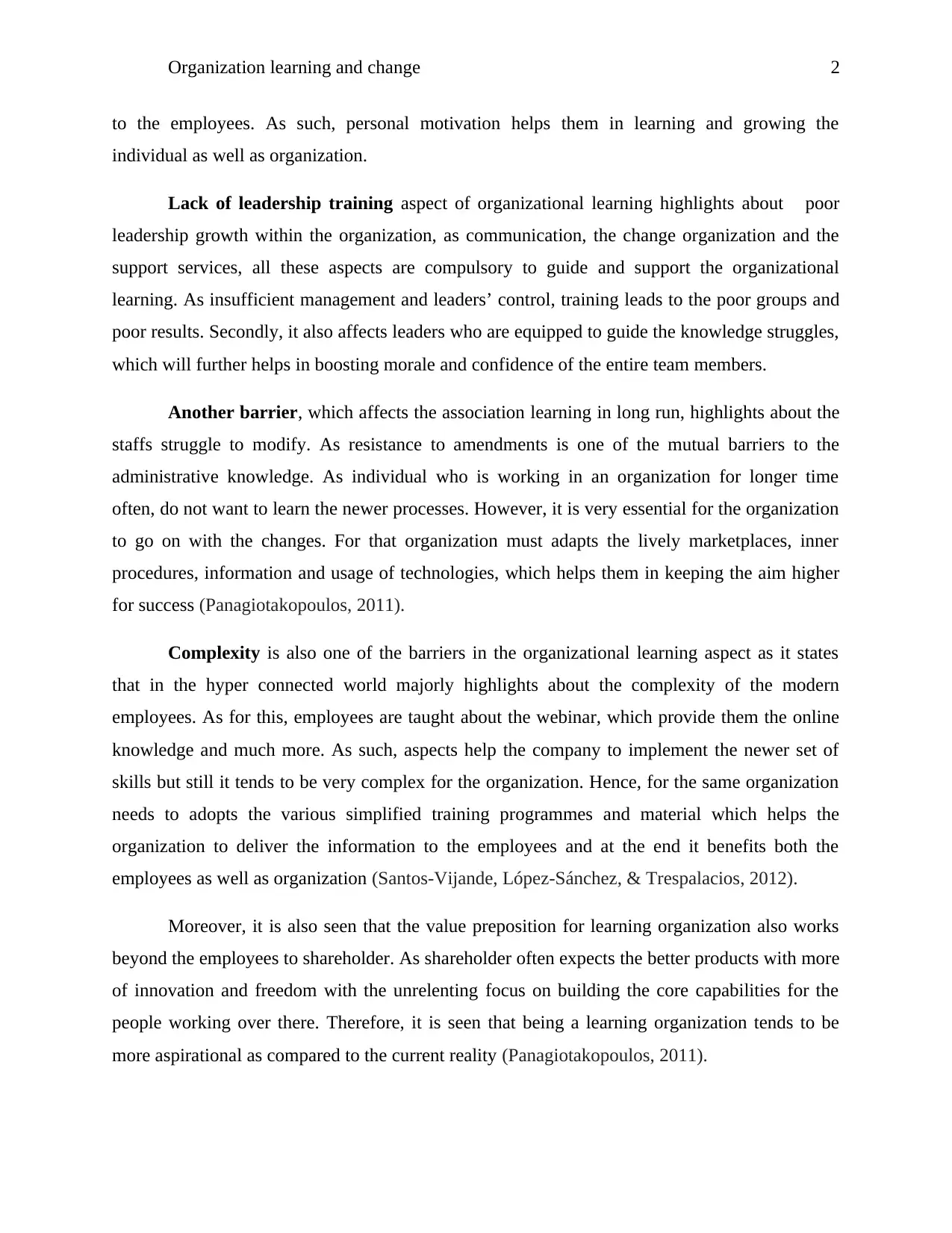
Organization learning and change 2
to the employees. As such, personal motivation helps them in learning and growing the
individual as well as organization.
Lack of leadership training aspect of organizational learning highlights about poor
leadership growth within the organization, as communication, the change organization and the
support services, all these aspects are compulsory to guide and support the organizational
learning. As insufficient management and leaders’ control, training leads to the poor groups and
poor results. Secondly, it also affects leaders who are equipped to guide the knowledge struggles,
which will further helps in boosting morale and confidence of the entire team members.
Another barrier, which affects the association learning in long run, highlights about the
staffs struggle to modify. As resistance to amendments is one of the mutual barriers to the
administrative knowledge. As individual who is working in an organization for longer time
often, do not want to learn the newer processes. However, it is very essential for the organization
to go on with the changes. For that organization must adapts the lively marketplaces, inner
procedures, information and usage of technologies, which helps them in keeping the aim higher
for success (Panagiotakopoulos, 2011).
Complexity is also one of the barriers in the organizational learning aspect as it states
that in the hyper connected world majorly highlights about the complexity of the modern
employees. As for this, employees are taught about the webinar, which provide them the online
knowledge and much more. As such, aspects help the company to implement the newer set of
skills but still it tends to be very complex for the organization. Hence, for the same organization
needs to adopts the various simplified training programmes and material which helps the
organization to deliver the information to the employees and at the end it benefits both the
employees as well as organization (Santos-Vijande, López-Sánchez, & Trespalacios, 2012).
Moreover, it is also seen that the value preposition for learning organization also works
beyond the employees to shareholder. As shareholder often expects the better products with more
of innovation and freedom with the unrelenting focus on building the core capabilities for the
people working over there. Therefore, it is seen that being a learning organization tends to be
more aspirational as compared to the current reality (Panagiotakopoulos, 2011).
to the employees. As such, personal motivation helps them in learning and growing the
individual as well as organization.
Lack of leadership training aspect of organizational learning highlights about poor
leadership growth within the organization, as communication, the change organization and the
support services, all these aspects are compulsory to guide and support the organizational
learning. As insufficient management and leaders’ control, training leads to the poor groups and
poor results. Secondly, it also affects leaders who are equipped to guide the knowledge struggles,
which will further helps in boosting morale and confidence of the entire team members.
Another barrier, which affects the association learning in long run, highlights about the
staffs struggle to modify. As resistance to amendments is one of the mutual barriers to the
administrative knowledge. As individual who is working in an organization for longer time
often, do not want to learn the newer processes. However, it is very essential for the organization
to go on with the changes. For that organization must adapts the lively marketplaces, inner
procedures, information and usage of technologies, which helps them in keeping the aim higher
for success (Panagiotakopoulos, 2011).
Complexity is also one of the barriers in the organizational learning aspect as it states
that in the hyper connected world majorly highlights about the complexity of the modern
employees. As for this, employees are taught about the webinar, which provide them the online
knowledge and much more. As such, aspects help the company to implement the newer set of
skills but still it tends to be very complex for the organization. Hence, for the same organization
needs to adopts the various simplified training programmes and material which helps the
organization to deliver the information to the employees and at the end it benefits both the
employees as well as organization (Santos-Vijande, López-Sánchez, & Trespalacios, 2012).
Moreover, it is also seen that the value preposition for learning organization also works
beyond the employees to shareholder. As shareholder often expects the better products with more
of innovation and freedom with the unrelenting focus on building the core capabilities for the
people working over there. Therefore, it is seen that being a learning organization tends to be
more aspirational as compared to the current reality (Panagiotakopoulos, 2011).
⊘ This is a preview!⊘
Do you want full access?
Subscribe today to unlock all pages.

Trusted by 1+ million students worldwide
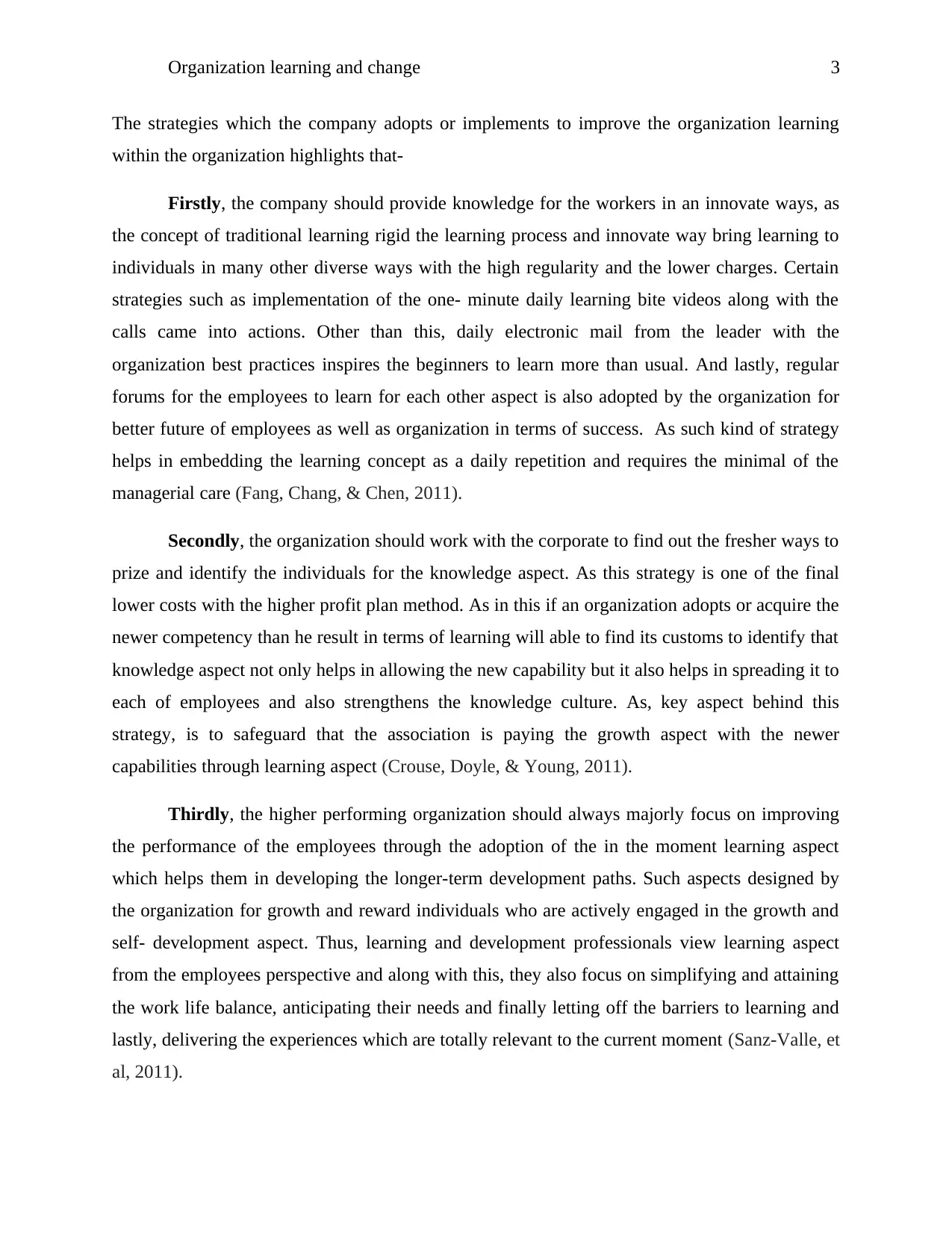
Organization learning and change 3
The strategies which the company adopts or implements to improve the organization learning
within the organization highlights that-
Firstly, the company should provide knowledge for the workers in an innovate ways, as
the concept of traditional learning rigid the learning process and innovate way bring learning to
individuals in many other diverse ways with the high regularity and the lower charges. Certain
strategies such as implementation of the one- minute daily learning bite videos along with the
calls came into actions. Other than this, daily electronic mail from the leader with the
organization best practices inspires the beginners to learn more than usual. And lastly, regular
forums for the employees to learn for each other aspect is also adopted by the organization for
better future of employees as well as organization in terms of success. As such kind of strategy
helps in embedding the learning concept as a daily repetition and requires the minimal of the
managerial care (Fang, Chang, & Chen, 2011).
Secondly, the organization should work with the corporate to find out the fresher ways to
prize and identify the individuals for the knowledge aspect. As this strategy is one of the final
lower costs with the higher profit plan method. As in this if an organization adopts or acquire the
newer competency than he result in terms of learning will able to find its customs to identify that
knowledge aspect not only helps in allowing the new capability but it also helps in spreading it to
each of employees and also strengthens the knowledge culture. As, key aspect behind this
strategy, is to safeguard that the association is paying the growth aspect with the newer
capabilities through learning aspect (Crouse, Doyle, & Young, 2011).
Thirdly, the higher performing organization should always majorly focus on improving
the performance of the employees through the adoption of the in the moment learning aspect
which helps them in developing the longer-term development paths. Such aspects designed by
the organization for growth and reward individuals who are actively engaged in the growth and
self- development aspect. Thus, learning and development professionals view learning aspect
from the employees perspective and along with this, they also focus on simplifying and attaining
the work life balance, anticipating their needs and finally letting off the barriers to learning and
lastly, delivering the experiences which are totally relevant to the current moment (Sanz-Valle, et
al, 2011).
The strategies which the company adopts or implements to improve the organization learning
within the organization highlights that-
Firstly, the company should provide knowledge for the workers in an innovate ways, as
the concept of traditional learning rigid the learning process and innovate way bring learning to
individuals in many other diverse ways with the high regularity and the lower charges. Certain
strategies such as implementation of the one- minute daily learning bite videos along with the
calls came into actions. Other than this, daily electronic mail from the leader with the
organization best practices inspires the beginners to learn more than usual. And lastly, regular
forums for the employees to learn for each other aspect is also adopted by the organization for
better future of employees as well as organization in terms of success. As such kind of strategy
helps in embedding the learning concept as a daily repetition and requires the minimal of the
managerial care (Fang, Chang, & Chen, 2011).
Secondly, the organization should work with the corporate to find out the fresher ways to
prize and identify the individuals for the knowledge aspect. As this strategy is one of the final
lower costs with the higher profit plan method. As in this if an organization adopts or acquire the
newer competency than he result in terms of learning will able to find its customs to identify that
knowledge aspect not only helps in allowing the new capability but it also helps in spreading it to
each of employees and also strengthens the knowledge culture. As, key aspect behind this
strategy, is to safeguard that the association is paying the growth aspect with the newer
capabilities through learning aspect (Crouse, Doyle, & Young, 2011).
Thirdly, the higher performing organization should always majorly focus on improving
the performance of the employees through the adoption of the in the moment learning aspect
which helps them in developing the longer-term development paths. Such aspects designed by
the organization for growth and reward individuals who are actively engaged in the growth and
self- development aspect. Thus, learning and development professionals view learning aspect
from the employees perspective and along with this, they also focus on simplifying and attaining
the work life balance, anticipating their needs and finally letting off the barriers to learning and
lastly, delivering the experiences which are totally relevant to the current moment (Sanz-Valle, et
al, 2011).
Paraphrase This Document
Need a fresh take? Get an instant paraphrase of this document with our AI Paraphraser
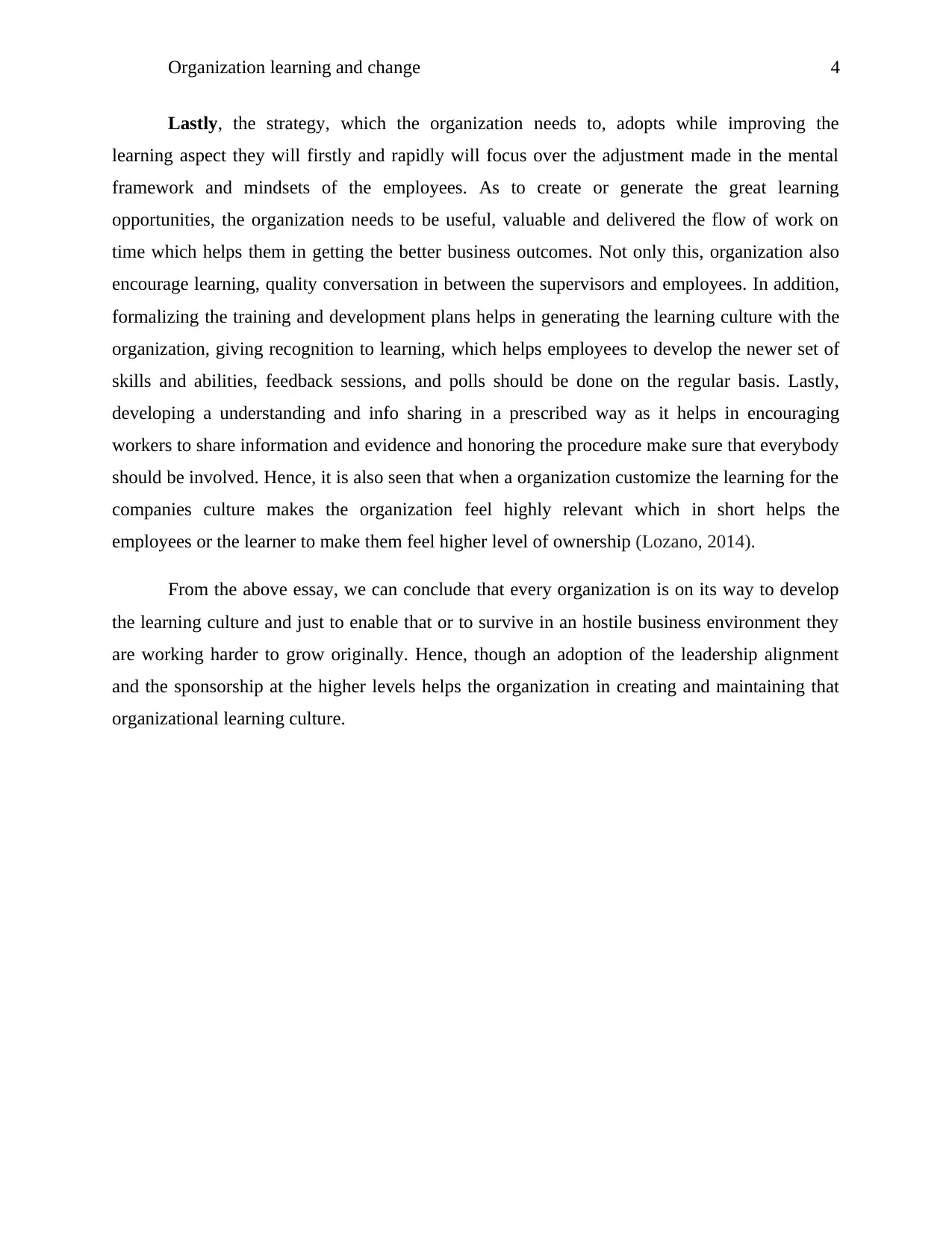
Organization learning and change 4
Lastly, the strategy, which the organization needs to, adopts while improving the
learning aspect they will firstly and rapidly will focus over the adjustment made in the mental
framework and mindsets of the employees. As to create or generate the great learning
opportunities, the organization needs to be useful, valuable and delivered the flow of work on
time which helps them in getting the better business outcomes. Not only this, organization also
encourage learning, quality conversation in between the supervisors and employees. In addition,
formalizing the training and development plans helps in generating the learning culture with the
organization, giving recognition to learning, which helps employees to develop the newer set of
skills and abilities, feedback sessions, and polls should be done on the regular basis. Lastly,
developing a understanding and info sharing in a prescribed way as it helps in encouraging
workers to share information and evidence and honoring the procedure make sure that everybody
should be involved. Hence, it is also seen that when a organization customize the learning for the
companies culture makes the organization feel highly relevant which in short helps the
employees or the learner to make them feel higher level of ownership (Lozano, 2014).
From the above essay, we can conclude that every organization is on its way to develop
the learning culture and just to enable that or to survive in an hostile business environment they
are working harder to grow originally. Hence, though an adoption of the leadership alignment
and the sponsorship at the higher levels helps the organization in creating and maintaining that
organizational learning culture.
Lastly, the strategy, which the organization needs to, adopts while improving the
learning aspect they will firstly and rapidly will focus over the adjustment made in the mental
framework and mindsets of the employees. As to create or generate the great learning
opportunities, the organization needs to be useful, valuable and delivered the flow of work on
time which helps them in getting the better business outcomes. Not only this, organization also
encourage learning, quality conversation in between the supervisors and employees. In addition,
formalizing the training and development plans helps in generating the learning culture with the
organization, giving recognition to learning, which helps employees to develop the newer set of
skills and abilities, feedback sessions, and polls should be done on the regular basis. Lastly,
developing a understanding and info sharing in a prescribed way as it helps in encouraging
workers to share information and evidence and honoring the procedure make sure that everybody
should be involved. Hence, it is also seen that when a organization customize the learning for the
companies culture makes the organization feel highly relevant which in short helps the
employees or the learner to make them feel higher level of ownership (Lozano, 2014).
From the above essay, we can conclude that every organization is on its way to develop
the learning culture and just to enable that or to survive in an hostile business environment they
are working harder to grow originally. Hence, though an adoption of the leadership alignment
and the sponsorship at the higher levels helps the organization in creating and maintaining that
organizational learning culture.
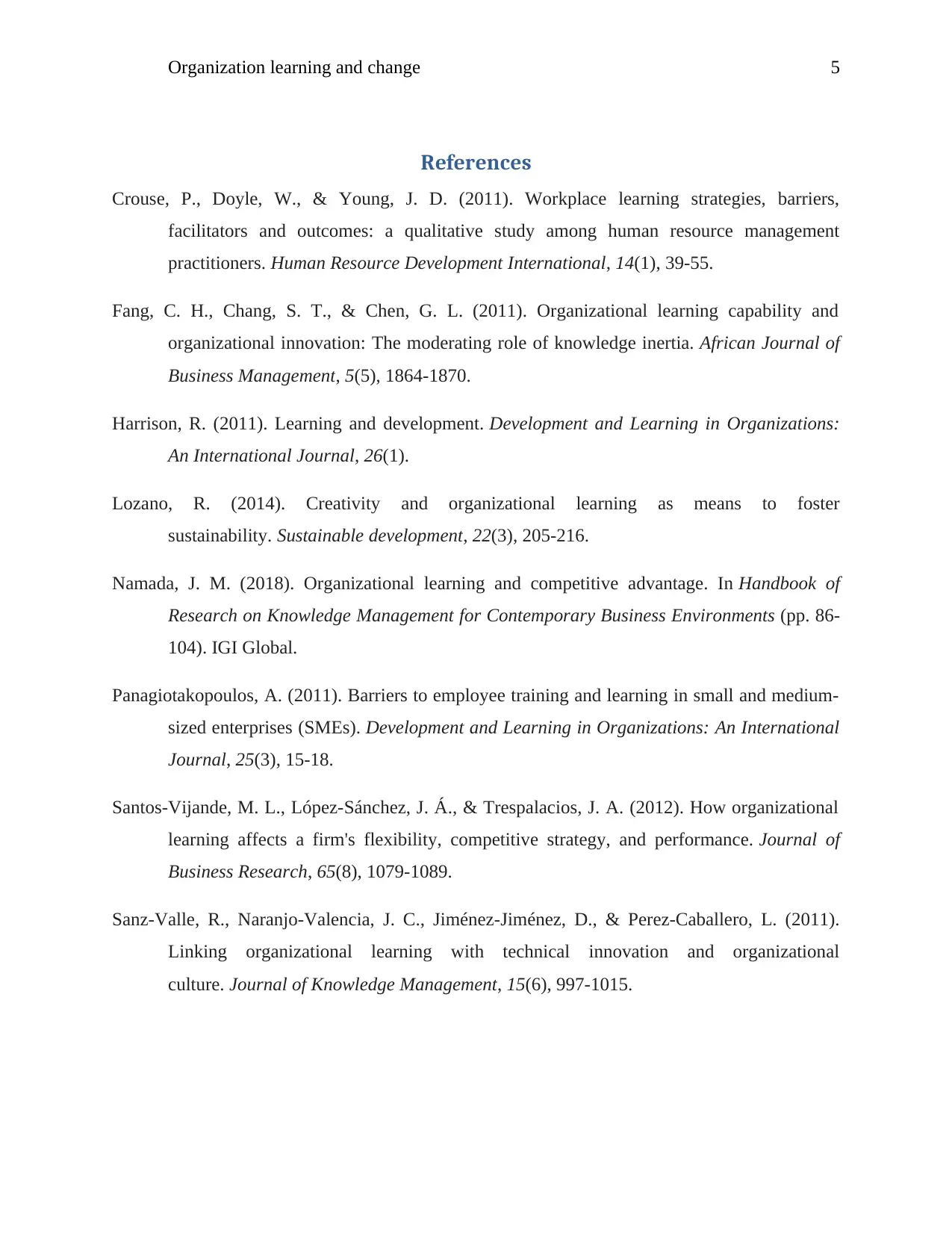
Organization learning and change 5
References
Crouse, P., Doyle, W., & Young, J. D. (2011). Workplace learning strategies, barriers,
facilitators and outcomes: a qualitative study among human resource management
practitioners. Human Resource Development International, 14(1), 39-55.
Fang, C. H., Chang, S. T., & Chen, G. L. (2011). Organizational learning capability and
organizational innovation: The moderating role of knowledge inertia. African Journal of
Business Management, 5(5), 1864-1870.
Harrison, R. (2011). Learning and development. Development and Learning in Organizations:
An International Journal, 26(1).
Lozano, R. (2014). Creativity and organizational learning as means to foster
sustainability. Sustainable development, 22(3), 205-216.
Namada, J. M. (2018). Organizational learning and competitive advantage. In Handbook of
Research on Knowledge Management for Contemporary Business Environments (pp. 86-
104). IGI Global.
Panagiotakopoulos, A. (2011). Barriers to employee training and learning in small and medium-
sized enterprises (SMEs). Development and Learning in Organizations: An International
Journal, 25(3), 15-18.
Santos-Vijande, M. L., López-Sánchez, J. Á., & Trespalacios, J. A. (2012). How organizational
learning affects a firm's flexibility, competitive strategy, and performance. Journal of
Business Research, 65(8), 1079-1089.
Sanz-Valle, R., Naranjo-Valencia, J. C., Jiménez-Jiménez, D., & Perez-Caballero, L. (2011).
Linking organizational learning with technical innovation and organizational
culture. Journal of Knowledge Management, 15(6), 997-1015.
References
Crouse, P., Doyle, W., & Young, J. D. (2011). Workplace learning strategies, barriers,
facilitators and outcomes: a qualitative study among human resource management
practitioners. Human Resource Development International, 14(1), 39-55.
Fang, C. H., Chang, S. T., & Chen, G. L. (2011). Organizational learning capability and
organizational innovation: The moderating role of knowledge inertia. African Journal of
Business Management, 5(5), 1864-1870.
Harrison, R. (2011). Learning and development. Development and Learning in Organizations:
An International Journal, 26(1).
Lozano, R. (2014). Creativity and organizational learning as means to foster
sustainability. Sustainable development, 22(3), 205-216.
Namada, J. M. (2018). Organizational learning and competitive advantage. In Handbook of
Research on Knowledge Management for Contemporary Business Environments (pp. 86-
104). IGI Global.
Panagiotakopoulos, A. (2011). Barriers to employee training and learning in small and medium-
sized enterprises (SMEs). Development and Learning in Organizations: An International
Journal, 25(3), 15-18.
Santos-Vijande, M. L., López-Sánchez, J. Á., & Trespalacios, J. A. (2012). How organizational
learning affects a firm's flexibility, competitive strategy, and performance. Journal of
Business Research, 65(8), 1079-1089.
Sanz-Valle, R., Naranjo-Valencia, J. C., Jiménez-Jiménez, D., & Perez-Caballero, L. (2011).
Linking organizational learning with technical innovation and organizational
culture. Journal of Knowledge Management, 15(6), 997-1015.
⊘ This is a preview!⊘
Do you want full access?
Subscribe today to unlock all pages.

Trusted by 1+ million students worldwide
1 out of 6
Related Documents
Your All-in-One AI-Powered Toolkit for Academic Success.
+13062052269
info@desklib.com
Available 24*7 on WhatsApp / Email
![[object Object]](/_next/static/media/star-bottom.7253800d.svg)
Unlock your academic potential
Copyright © 2020–2025 A2Z Services. All Rights Reserved. Developed and managed by ZUCOL.





